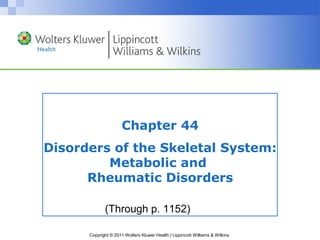More Related Content
Similar to Week 4 Powerpoint Chapter 44 (20)
More from stanbridge (20)
Week 4 Powerpoint Chapter 44
- 1. Chapter 44
Disorders of the Skeletal System:
Metabolic and
Rheumatic Disorders
(Through p. 1152)
Copyright © 2011 Wolters Kluwer Health | Lippincott Williams & Wilkins
- 2. Normal Bone Remodeling
• Osteoblasts are “bone building” cells
• They control bone remodeling by:
– Laying down new bone
– Secreting a compound (RANK ligand) that
controls the osteoclasts, the “bone breaking”
cells
• Normally, bone formation and breakdown are
balanced to:
– Replace damaged bone
– Maintain the amount and density of bone
Copyright © 2011 Wolters Kluwer Health | Lippincott Williams & Wilkins
- 3. Bone Growth
• Bone cells and bone marrow cells produce
osteoprotegerin (OPG)
– The osteoclasts are not told to function
– Bone breakdown decreases
– Bones grow
Copyright © 2011 Wolters Kluwer Health | Lippincott Williams & Wilkins
- 4. Question
True or false.
When osteoblasts work harder than osteoclasts, bones
grow.
Copyright © 2011 Wolters Kluwer Health | Lippincott Williams & Wilkins
- 5. Answer
True
Osteoblasts build bone tissue; when they are more active
than osteoclasts, bone grows. When osteoclasts work
harder than osteoblasts, more bone is broken down.
Copyright © 2011 Wolters Kluwer Health | Lippincott Williams & Wilkins
- 6. Think about…
How is bone remodeling affected by the following?
• Vitamin D?
• Mechanical stress?
• Calcitonin?
• Vitamin C?
Copyright © 2011 Wolters Kluwer Health | Lippincott Williams & Wilkins
- 7. Osteopenia and Osteoporosis
• Osteopenia
– Decreased bone
• Osteoporosis
– Decreased bone mass
– Decreased cancellous (spongy) bone strength
Copyright © 2011 Wolters Kluwer Health | Lippincott Williams & Wilkins
- 8. Discussion
Why are each of these people prone to osteoporosis?
• A postmenopausal woman
• A 70-year-old man
• A hyperthyroid alcoholic
• An Olympic figure skater who takes steroids to
reduce joint inflammation
• A man with a lung tumor that secretes PTH
Copyright © 2011 Wolters Kluwer Health | Lippincott Williams & Wilkins
- 9. Osteomalacia
• Bone is not mineralized properly; it is not
rigid
• It is caused by:
– Insufficient calcium absorption
– Insufficient phosphate
• It results in:
– Bone pain and tenderness
– Fractures
– Deformities
Copyright © 2011 Wolters Kluwer Health | Lippincott Williams & Wilkins
- 10. Rickets
• Several forms:
– Nutritional
• Inadequate sunlight exposure, inadequate
Vitamin D intake, inadequate calcium or
phosphate intake
– Vitamin D dependent
• Chromosomal abnormality
– Vitamin D resistant
• Often involves hypophosphatemia
Copyright © 2011 Wolters Kluwer Health | Lippincott Williams & Wilkins
- 11. Paget Disease
• Second most common bone disease after
osteoporosis
• Both genetic and environmental influences
• Characterized by:
– Regions of excessive bone turnover
– New bone is disorganized
– Deformation and fracture common
Copyright © 2011 Wolters Kluwer Health | Lippincott Williams & Wilkins
- 12. Question
Which bone disorder is characterized by “soft” bones?
a. Osteopenia
b. Osteomyelitis
c. Rickets
d. Paget disease
Copyright © 2011 Wolters Kluwer Health | Lippincott Williams & Wilkins
- 13. Answer
c. Rickets
Calcium need vitamin D in order to be absorbed. In the
case of vitamin D deficiency (rickets), calcium cannot be
absorbed, and bones become soft.
Copyright © 2011 Wolters Kluwer Health | Lippincott Williams & Wilkins
- 14. Rheumatoid Arthritis
• Autoimmune disorder
• Antibodies against IgG fragments
• Cause inflammation in the joint
• Abnormal healing responses lay down granulation
tissue (pannus)
Copyright © 2011 Wolters Kluwer Health | Lippincott Williams & Wilkins
- 15. Treatment of Rheumatoid Arthritis
• NSAIDs
• Corticosteroids
• Leflunomide
• Influximab
Copyright © 2011 Wolters Kluwer Health | Lippincott Williams & Wilkins
- 16. Systemic Lupus Erythematosus (SLE)
• Autoantibodies include:
– Antinuclear antibodies (ANA)
– Antibodies against RBCs
– Antibodies against platelets
– Antibodies against coagulation factors
Copyright © 2011 Wolters Kluwer Health | Lippincott Williams & Wilkins
- 17. SLE Can Damage Any Tissue
• Arthralgia
• Skin lesions (butterfly rash)
• Glomerulonephritis
• Pleuritis
• Pericarditis
• Atherosclerosis
• CNS inflammations
Copyright © 2011 Wolters Kluwer Health | Lippincott Williams & Wilkins
- 18. Question
SLE produces antibodies against all but which of the
following?
a. RBCs
b. WBCs
c. Platelets
d. Coagulation factors
Copyright © 2011 Wolters Kluwer Health | Lippincott Williams & Wilkins
- 19. Answer
b. WBCs
SLE is an autoimmune disease that results in the
production of the following antibodies: antinuclear
antibodies, and antibodies against RBCs, platelets, and
coagulation factors. WBCs are not affected.
Copyright © 2011 Wolters Kluwer Health | Lippincott Williams & Wilkins
- 20. Systemic Sclerosis (Scleroderma)
• Collagen deposits in skin and internal organs
Spondyloarthropathies
• Inflammation at the insertions of tendons
and ligaments
Copyright © 2011 Wolters Kluwer Health | Lippincott Williams & Wilkins
- 21. Reactive Arthropathies
• Sterile joint inflammations caused by previous
infection
• The joints are not infected at the time of
inflammation
• Can follow infection with many agents including:
– Chlamydia
– Pseudomonas
– Streptococcus
– HIV
Copyright © 2011 Wolters Kluwer Health | Lippincott Williams & Wilkins
- 22. Osteoarthritis Syndrome
• Degenerative joint disease
• Inflammation of the joints often secondary to
physical damage
• Damaged joint cartilage tries to heal itself
– Creating osteophytes or spurs
• Cartilage contains more water, less collagen
– Cartilage becomes weak, rough, eroded
– No longer protects the surface of the bone
Copyright © 2011 Wolters Kluwer Health | Lippincott Williams & Wilkins
- 23. Gout Syndrome
• Increased serum uric
acid
• Crystals precipitate in
the joint
• Inflammation results
• Tophi are deposits
containing monosodium
urate crystals
Copyright © 2011 Wolters Kluwer Health | Lippincott Williams & Wilkins
